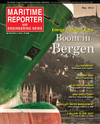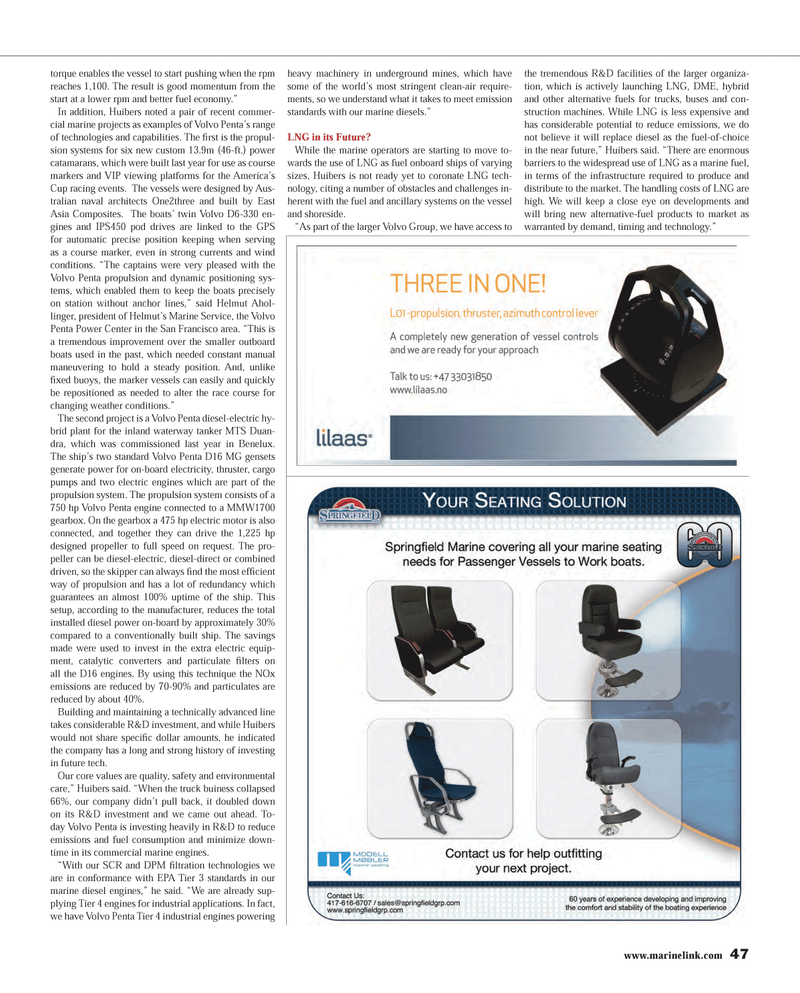
Page 47: of Maritime Reporter Magazine (May 2013)
Energy Production & Transportation
Read this page in Pdf, Flash or Html5 edition of May 2013 Maritime Reporter Magazine
www.marinelink.com 47torque enables the vessel to start pushing when the rpm reaches 1,100. The result is good momentum from the start at a lower rpm and better fuel economy.? In addition, Huibers noted a pair of recent commer- cial marine projects as examples of Volvo Penta?s range of technologies and capabilities. The Þ rst is the propul- sion systems for six new custom 13.9m (46-ft.) power catamarans, which were built last year for use as course markers and VIP viewing platforms for the America?s Cup racing events. The vessels were designed by Aus- tralian naval architects One2three and built by East Asia Composites. The boats? twin Volvo D6-330 en- gines and IPS450 pod drives are linked to the GPS for automatic precise position keeping when serving as a course marker, even in strong currents and wind conditions. ?The captains were very pleased with the Volvo Penta propulsion and dynamic positioning sys- tems, which enabled them to keep the boats precisely on station without anchor lines,? said Helmut Ahol- linger, president of Helmut?s Marine Service, the Volvo Penta Power Center in the San Francisco area. ?This is a tremendous improvement over the smaller outboard boats used in the past, which needed constant manual maneuvering to hold a steady position. And, unlike Þ xed buoys, the marker vessels can easily and quickly be repositioned as needed to alter the race course for changing weather conditions.?The second project is a Volvo Penta diesel-electric hy- brid plant for the inland waterway tanker MTS Duan-dra, which was commissioned last year in Benelux. The ship?s two standard Volvo Penta D16 MG gensets generate power for on-board electricity, thruster, cargo pumps and two electric engines which are part of the propulsion system. The propulsion system consists of a 750 hp Volvo Penta engine connected to a MMW1700 gearbox. On the gearbox a 475 hp electric motor is also connected, and together they can drive the 1,225 hp designed propeller to full speed on request. The pro- peller can be diesel-electric, diesel-direct or combined driven, so the skipper can always Þ nd the most ef Þ cient way of propulsion and has a lot of redundancy which guarantees an almost 100% uptime of the ship. This setup, according to the manufacturer, reduces the total installed diesel power on-board by approximately 30% compared to a conventionally built ship. The savings made were used to invest in the extra electric equip-ment, catalytic converters and particulate Þ lters on all the D16 engines. By using this technique the NOx emissions are reduced by 70-90% and particulates are reduced by about 40%.Building and maintaining a technically advanced line takes considerable R&D investment, and while Huibers would not share speciÞ c dollar amounts, he indicated the company has a long and strong history of investing in future tech.Our core values are quality, safety and environmental care,? Huibers said. ?When the truck buiness collapsed 66%, our company didn?t pull back, it doubled down on its R&D investment and we came out ahead. To- day Volvo Penta is investing heavily in R&D to reduce emissions and fuel consumption and minimize down-time in its commercial marine engines. ?With our SCR and DPM Þ ltration technologies we are in conformance with EPA Tier 3 standards in our marine diesel engines,? he said. ?We are already sup- plying Tier 4 engines for industrial applications. In fact, we have Volvo Penta Tier 4 industrial engines powering heavy machinery in underground mines, which have some of the world?s most stringent clean-air require- ments, so we understand what it takes to meet emission standards with our marine diesels.?LNG in its Future? While the marine operators are starting to move to-wards the use of LNG as fuel onboard ships of varying sizes, Huibers is not ready yet to coronate LNG tech-nology, citing a number of obstacles and challenges in-herent with the fuel and ancillary systems on the vessel and shoreside.?As part of the larger Volvo Group, we have access to the tremendous R&D facilities of the larger organiza- tion, which is actively launching LNG, DME, hybrid and other alternative fuels for trucks, buses and con-struction machines. While LNG is less expensive and has considerable potential to reduce emissions, we do not believe it will replace diesel as the fuel-of-choice in the near future,? Huibers said. ?There are enormous barriers to the widespread use of LNG as a marine fuel, in terms of the infrastructure required to produce and distribute to the market. The handling costs of LNG are high. We will keep a close eye on developments and will bring new alternative-fuel products to market as warranted by demand, timing and technology.? MR #5 (42-49).indd 47MR #5 (42-49).indd 475/3/2013 3:20:42 PM5/3/2013 3:20:42 PM

 46
46

 48
48
